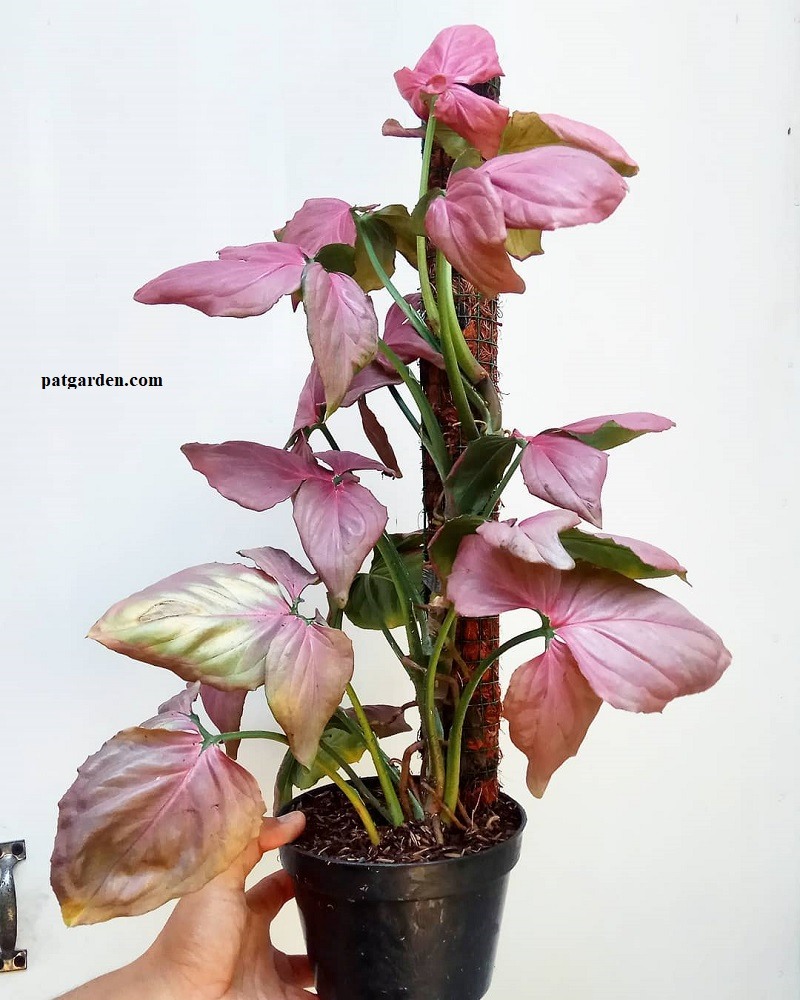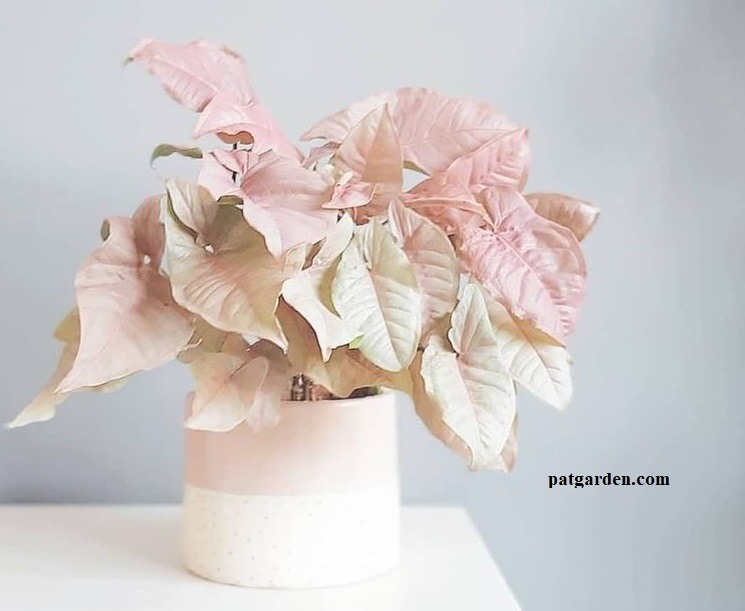Pink Syngonium (arrowhead vine) is my favorite houseplant due to its foliage patterns and striking colors. Besides that, growing and caring for arrowhead vines is super easy.
Pink Syngonium care involves the provision of bright indirect sunlight, well-draining soil, high humidity, and a temperature range of 60-85oF (15-30oC). Apply slow-release fertilizer every early summer and prune old leaves to maintain their beautiful appearance.
I wrote this article guide to share hacks for arrowhead plant care and everything you need to know about this beautiful houseplant. Take the time to read through the common problems and their respective solutions.
What Does a Pink Syngonium Look Like?

A pink Syngonium (Syngonium podophyllum) is a hardy evergreen plant with dusty pink colorations. The vibrant colors and patterned foliages give this houseplant stunning looks.
The houseplant can grow up to 3-6 ft tall and 2ft wide. It comes in several varieties with distinctive foliage patterns and coloration.
The Syngonium podophyllum plant is also called arrowhead vine, goosefoot plant, arrowhead ivy, arrowhead philodendron, or arrowhead plant.
The arrowhead plant hails from Mexico, Brazil, Ecuador, West Indies, and Bolivia. This beautiful plant thrives well under indoor settings to add an aesthetic appearance.
The vines can grow and spread in all directions. I recommend trimming the vines to make this houseplant have a compact appearance.
The pink Syngonium plant contains some toxic elements. These elements can get worse if ingested. Always try to keep the plant away from toddlers and pets.
Growing and caring for pink Syngonium plant is a no-brainer task since its requirements aren’t that complicated. Keep reading this guide to become a successful grower.
Pink Syngonium Care Details
| Origin | Mexico, Bolivia, West Indies, Ecuador, and Brazil. |
| Scientific Name | Syngonium podophyllum. |
| Common Names | Goosefoot plant, Arrowhead Vine, Arrowhead Vine, and Arrowhead Ivy. |
| Family | Araceae |
| Pink Syngonium Varieties | Neon Robusta, Imperial White, Painted Arrow, Holy, Strawberry Cream, Pink Allusion, Berry Allusion. |
| Maximum Growth (Approx.) | 3-6ft tall and 2ft wide. |
| Watering Requirements | Juvenile plants need less water. Mature plants require frequent watering. |
| Light Requirements | Bright indirect sunlight. But can also thrive under medium indirect sunlight. |
| Humidity Needs | Average humidity level (40%). |
| Soil Requirements | A fertile and well-draining soil. |
| Fertilizer Application | Apply slow release fertilizer to the plant every early spring. |
| Pruning and Maintenance | Trim vines and old leaves to maintain compact shape. |
| Season | Growing seasons are Feb to May and July to Sept. |
| Temperature Requirements | 60-85oF (15-30oC). |
| Pests | Mealybugs and Spider mites |
| Diseases | Stem rot and bacterial blight |
| Toxicity | Poisonous to pets and children when ingested. |
How to Care for Pink Syngonium
Understanding arrowhead vine care requirements will make you a successful grower. Below are quick pink syngonium care tips to consider:
Pink Syngonium Watering Requirements
Watering an arrowhead plant is a crucial technique to master. Ensure the potting soil is slightly moist to enhance better growth and health.
Overwatering the arrowhead vines will result in root rot and yellowing of leaves. Besides that, under-watering will cause arrowhead leaves to curl and turn brown.
I recommend watering the goosefoot plant once or twice a week during spring and summer. Be sure to reduce the watering frequency during the winter season.
Below are quick tips for watering pink Syngonium plant:
- Use distilled water or rainwater to irrigate your plants. Avoid tap water since it contains minerals that will ruin the appearance of your houseplant.
- Inspect the soil moisture content before hydrating your arrowhead plant. It helps prevent under-watering or overwatering problems.
Pink Syngonium Light Requirements
Arrowhead plants thrive under medium to bright indirect sunlight. But some pink Syngonium varieties can tolerate low-lighting conditions.
Pink Syngonium species with dark leaves prefer a space with low light. Those species with light-colored leaves thrive in bright indirect sunlight.
Low-lighting conditions will make your houseplant experience stunted growth and have scarce foliages. Besides that, the vibrant colors will begin to fade over time.
Direct sunlight exposure will scorch the leaves and make the plant wilt. Arrowhead vine varieties with yellow, pink, and green leaves will also get discolored.
Below are quick tips to consider:
- Place the plant near an east-facing or north-facing window with curtains.
- Grow the pink Syngonium in a hanging basket under medium to bright indirect sunlight.
Pink Syngonium Temperature Range
Arrowhead plants prefer ideal room temperature to grow and produce striking foliage colors. I recommend a temperature range of 60-80oF (15-30oC).
Freezing temperatures will make the houseplant experience stunted growth. And high temperatures can cause arrowhead leaves to curl and droop.
Always keep the pink Syngonium plant away from heaters, air vents, windowsills, drafts, and radiators. These devices and conditions usually result in extreme temperature changes.
I recommend taking your goosefoot plant outside in the morning or late evening during summer to enjoy the natural light. It also helps nourish the plant foliages to develop vibrant colors.
Below are quick tips to consider:
- Keep the houseplant away from cold and hot drafts.
- Use a digital thermometer to monitor indoor temperature changes.
Pink Syngonium Humidity Requirements
Arrowhead vines are naïve to the tropical rainforest in Ecuador, Brazil, Mexico, Bolivia, and West Indies. The natural habitat experiences high humidity to keep the foliage patterns pretty.
Every houseplant enthusiast needs to replicate the condition at home. Ensure the pink Syngonium plant receives an average humidity of about 40-50%.
Below are quick tips to increase humidity around the arrowhead plant:
- Use an electric humidifier to boost indoor humidity levels.
- Mist the leaves once a week with distilled water in a spray bottle.
- Wipe the leaves twice a week with a damp lint cloth to remove dust and increase humidity.
Pink Syngonium Soil Requirements
Arrowhead plant thrives in fertile and well-draining soil with a pH range of 5.5 to 6.5. The environment helps the houseplant stay healthy and happy.
I recommend mixing equal amounts of perlite, potting soil, and peat moss. The perlites help improve the drainage, and peat moss holds moderate moisture.
Improper soil drainage will result in stunted growth and arrowhead leaves turning yellow. It occurs due to poor air circulation around the roots.
Arrowhead Vine Fertilizer Requirements
A pink Syngonium plant isn’t a heavy feeder like other tropical houseplants. It can also thrive with or without fertilizer application.
But the fertilizer nutrients and minerals will make your houseplant experience better growth. I recommend using a slow-release fertilizer during early spring and summer.
Do not apply fertilizer to your arrowhead plants during winter and fall. The fertilizer nutrients and minerals will remain underutilized to cause over-fertilization issues.
Below are quick tips for pink Syngonium fertilizer application:
- Feed the plant every two weeks during spring and summer.
- Flash the potting mix every month to avoid toxic nutrient accumulation.
Pink Syngonium Propagation
Arrowhead vine propagation is through stem cuttings. I recommend cutting the stem close to the roots during the spring season.
Ensure the section chosen has 3 to 4 leaves before cutting. Place the stem cuttings in water for the roots to develop. It will take a few days for the roots to start appearing.
Transplant the cuttings in a small pot with moist and well-draining soil. Place the pot in a region that receives medium to bright indirect sunlight.
How to Repot Pink Syngonium
Arrowhead vines are vulnerable to root-bound problems. Re-potting the houseplant once a year will help it flourish without facing issues.
I recommend using a fresh potting mix and a slightly larger container. Trim the root tips to facilitate faster development and growth.
Pruning and Maintenance
Pruning is a vital maintenance routine when growing arrowhead plants. It helps remove overgrown vines and maintain a compact shape appearance.
The routine helps make this houseplant ideal for hanging baskets and tabletop due to its bushy appearance. Always prune this houseplant during the spring season due to the active growth rate.
Common Pink Syngonium Problems and Solutions
Pest Infestations
Arrowhead plants are hardy evergreens that are less vulnerable to insect infestations. But this does not make the houseplant invincible to pests.
Mealybugs and spider mites are the leading pests that attack arrowhead vines. I recommend using an insecticidal soap solution to eliminate these creatures.
Plant Diseases
Root rot and bacterial blight are the leading plant diseases that affect pink Syngonium plants. It occurs due to overwatering and inappropriate ventilation.
Use well-draining soil and a pot with drainage holes to eliminate excess water. Place the houseplant in a space to experience the free flow of air.
Pink Syngonium Dying
Overwatering is the leading cause of arrowhead vine death. The excess moisture causes root rot that makes leaves turn black and die.
Master the appropriate watering techniques to save your overwatered arrowhead plant. Be sure to use well-draining soil and a pot with drainage holes at the bottom.
Pink Syngonium Leaves Curling
Inconsistent watering habit and pest infestations are the leading cause of arrowhead plant leaves curling problem. Rehydrate your houseplant and use insecticidal soap to kill the pests.
Pink Syngonium Leaves Turning Green
Over-feeding your pink syngonium plant will make it lose its bright colors. Moderate the slow-release fertilizer application to combat the green coloration effect.
Pink Syngonium Leaves Turning Brown
Direct sunlight exposure, overwatering, and over-fertilization are the leading causes of arrowhead leaves turning brown.
I recommend growing the houseplant under medium to bright indirect sunlight. Follow a strict watering schedule and reduce fertilizer application frequency.
Is Pink Syngonium Poisonous?
Arrowhead plants have poisonous elements in their stems and leaves. Ingesting these plant parts can cause severe problems.
So, is pink Syngonium poisonous? Yes. The plant contains calcium oxalate that can cause oral swellings, drooling and gastric irritations in humans or pets.
According to ASPCA, arrowhead vines are toxic to dogs, cats, and toddlers. Keep the houseplant away from children and pets to avoid ingestion.

Final Word
An arrowhead plant is among the easiest houseplant to grow and care for, regardless of an individual’s experience level.
How to care for pink Syngonium involves the provision of bright indirect sunlight, well-draining soil, moderate watering routine, high humidity, and feeding every two weeks during spring.
I hope this article guide will help you become a successful grower. Feel free to share with your friends or families in any community.
You May Also Like:
